Evidence-Based Practice: Rehabilitation Post CABG for Mental Health
VerifiedAdded on 2023/06/10
|21
|6426
|419
Report
AI Summary
This report provides an evidence-based review of cardiac rehabilitation programs for patients post-Coronary Artery Bypass Graft (CABG) surgery, focusing on the management of depression and anxiety. It begins with a PRISMA diagram illustrating participant enrollment and exclusion, followed by a rationale for article selection. The report summarizes a critical appraisal of existing research, highlighting the prevalence of heart disorders and the role of CABG as a treatment. It emphasizes the importance of cardiac rehabilitation as a secondary prevention method and its impact on improving the mental and social conditions of post-CABG patients. The review includes details on various assessment tools like the Beck's Depression Inventory and Spielberg's anxiety scale. Furthermore, the report discusses the practical applications of cardiac rehabilitation, including its effects on mortality rates, quality of life, and readmission rates. It concludes that cardiac rehabilitation programs, consisting of exercise and education, can effectively reduce depression and anxiety levels in post-CABG patients, stressing the need for early intervention and dedicated cardiac rehabilitation departments.
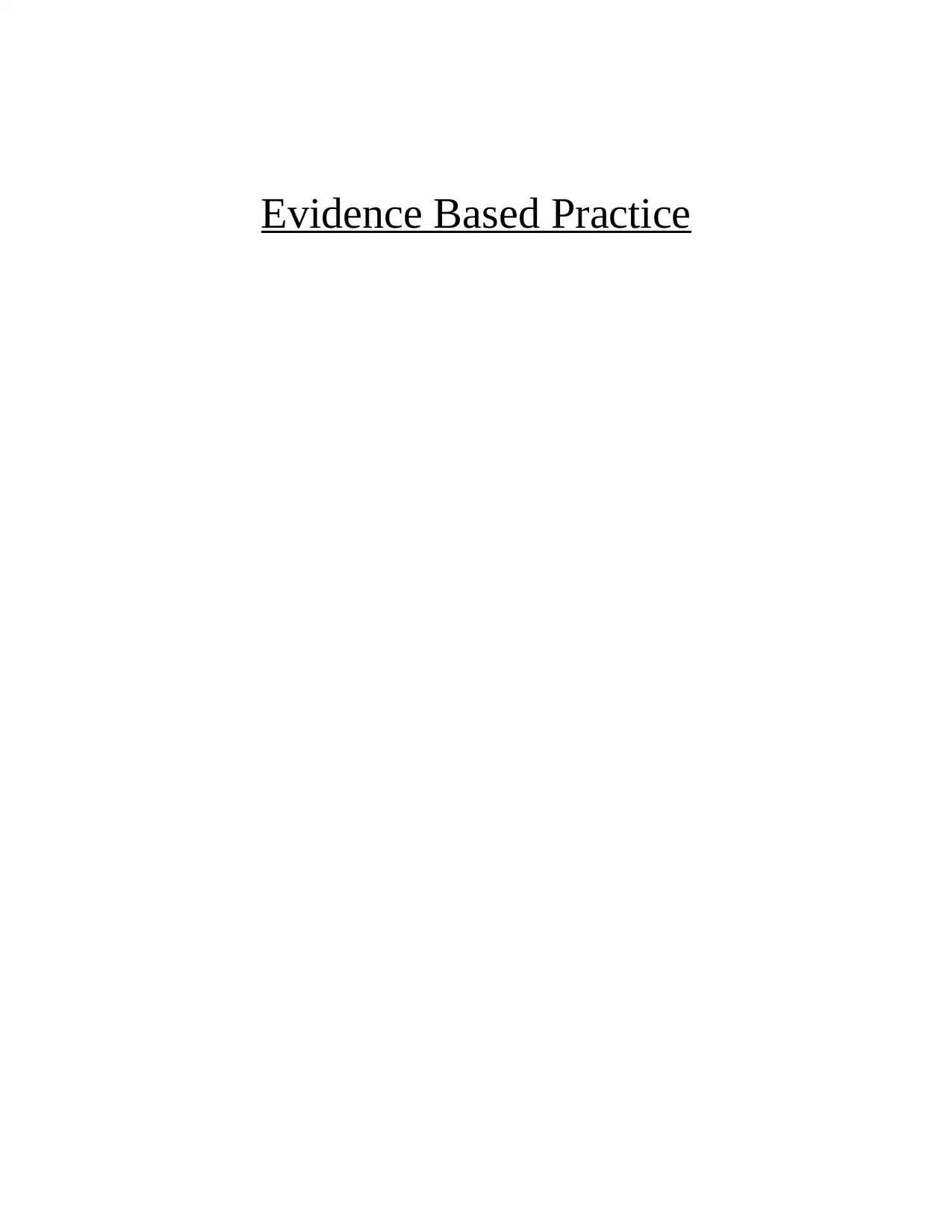
Evidence Based Practice
Paraphrase This Document
Need a fresh take? Get an instant paraphrase of this document with our AI Paraphraser
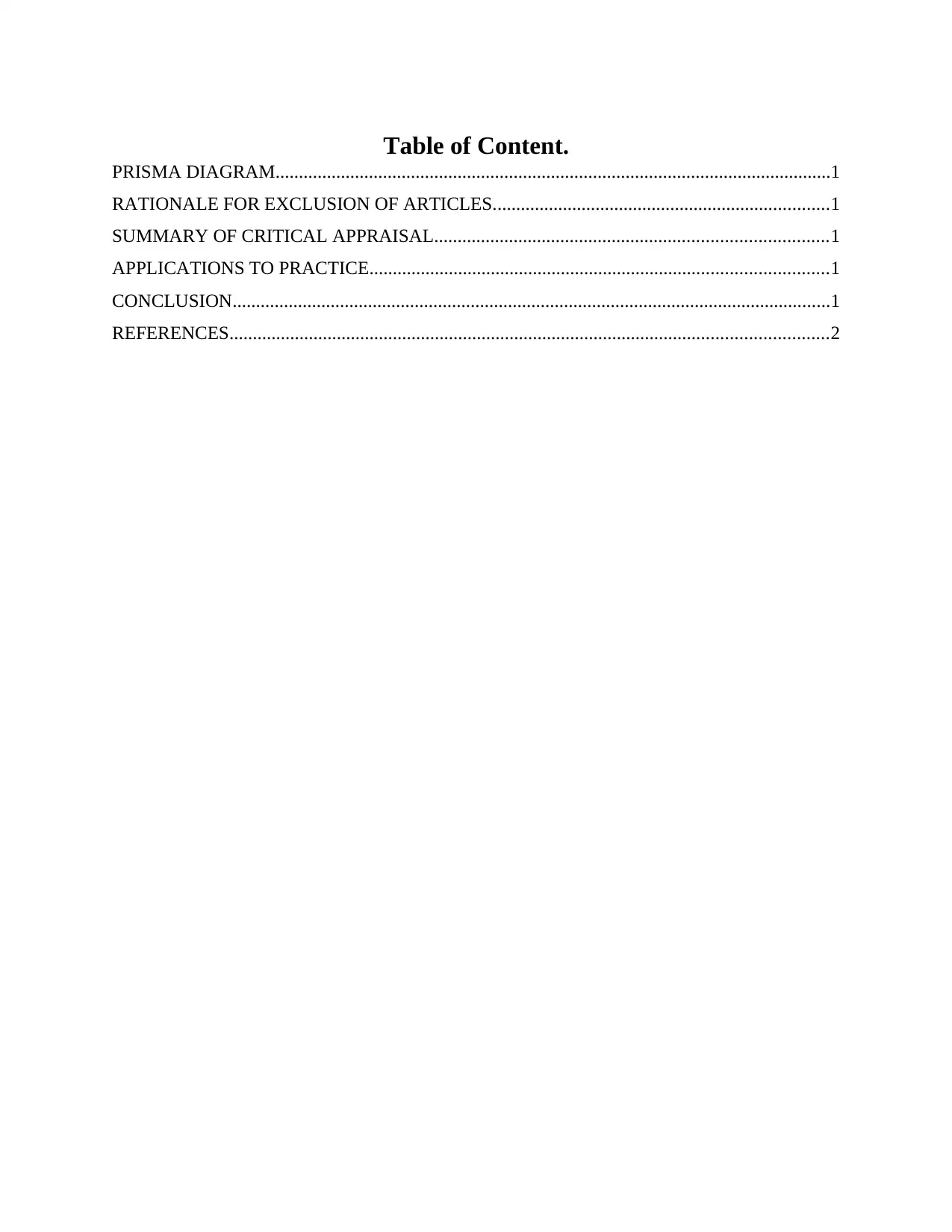
Table of Content.
PRISMA DIAGRAM.......................................................................................................................1
RATIONALE FOR EXCLUSION OF ARTICLES........................................................................1
SUMMARY OF CRITICAL APPRAISAL....................................................................................1
APPLICATIONS TO PRACTICE..................................................................................................1
CONCLUSION................................................................................................................................1
REFERENCES................................................................................................................................2
PRISMA DIAGRAM.......................................................................................................................1
RATIONALE FOR EXCLUSION OF ARTICLES........................................................................1
SUMMARY OF CRITICAL APPRAISAL....................................................................................1
APPLICATIONS TO PRACTICE..................................................................................................1
CONCLUSION................................................................................................................................1
REFERENCES................................................................................................................................2
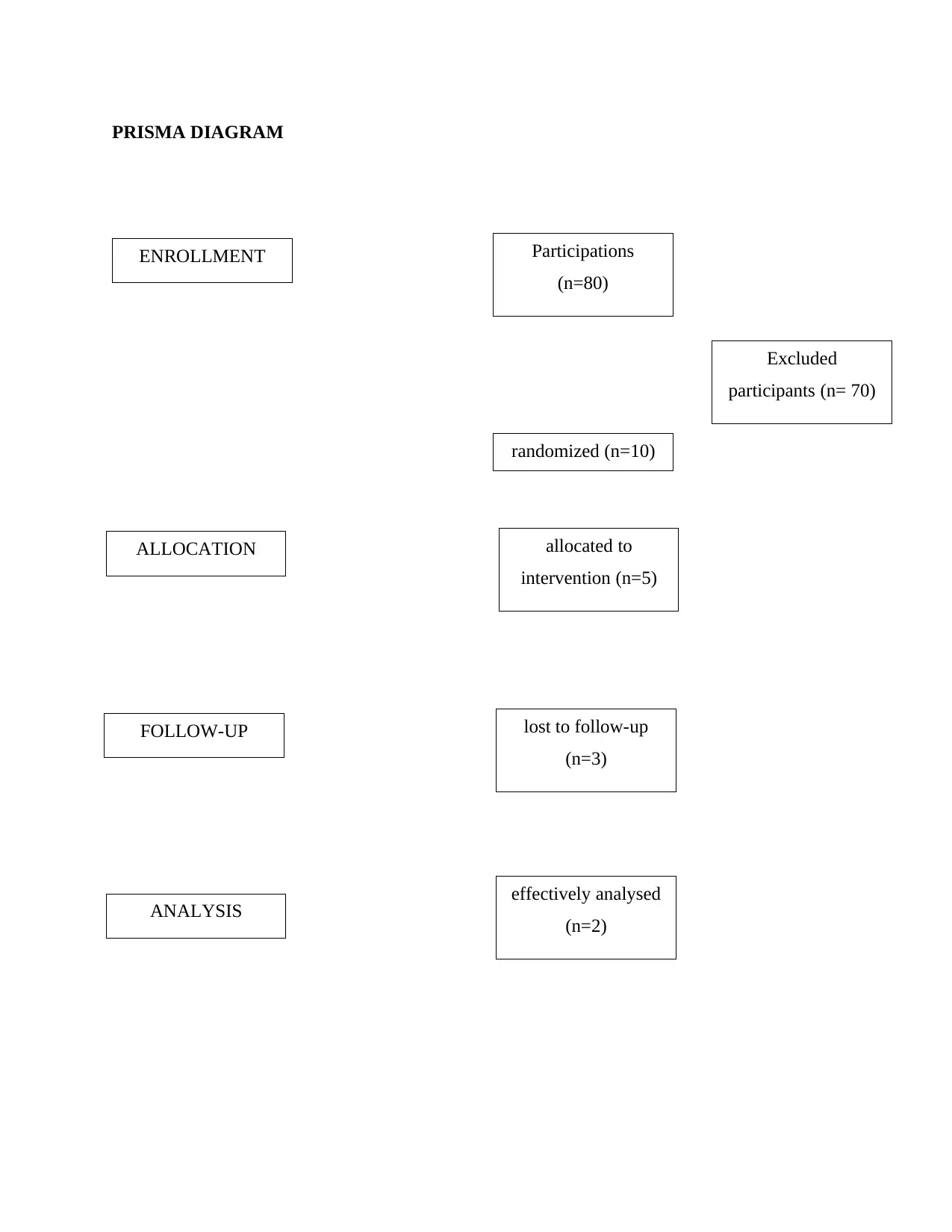
PRISMA DIAGRAM
ENROLLMENT
ALLOCATION
FOLLOW-UP
ANALYSIS
Participations
(n=80)
Excluded
participants (n= 70)
randomized (n=10)
allocated to
intervention (n=5)
lost to follow-up
(n=3)
effectively analysed
(n=2)
ENROLLMENT
ALLOCATION
FOLLOW-UP
ANALYSIS
Participations
(n=80)
Excluded
participants (n= 70)
randomized (n=10)
allocated to
intervention (n=5)
lost to follow-up
(n=3)
effectively analysed
(n=2)
⊘ This is a preview!⊘
Do you want full access?
Subscribe today to unlock all pages.

Trusted by 1+ million students worldwide
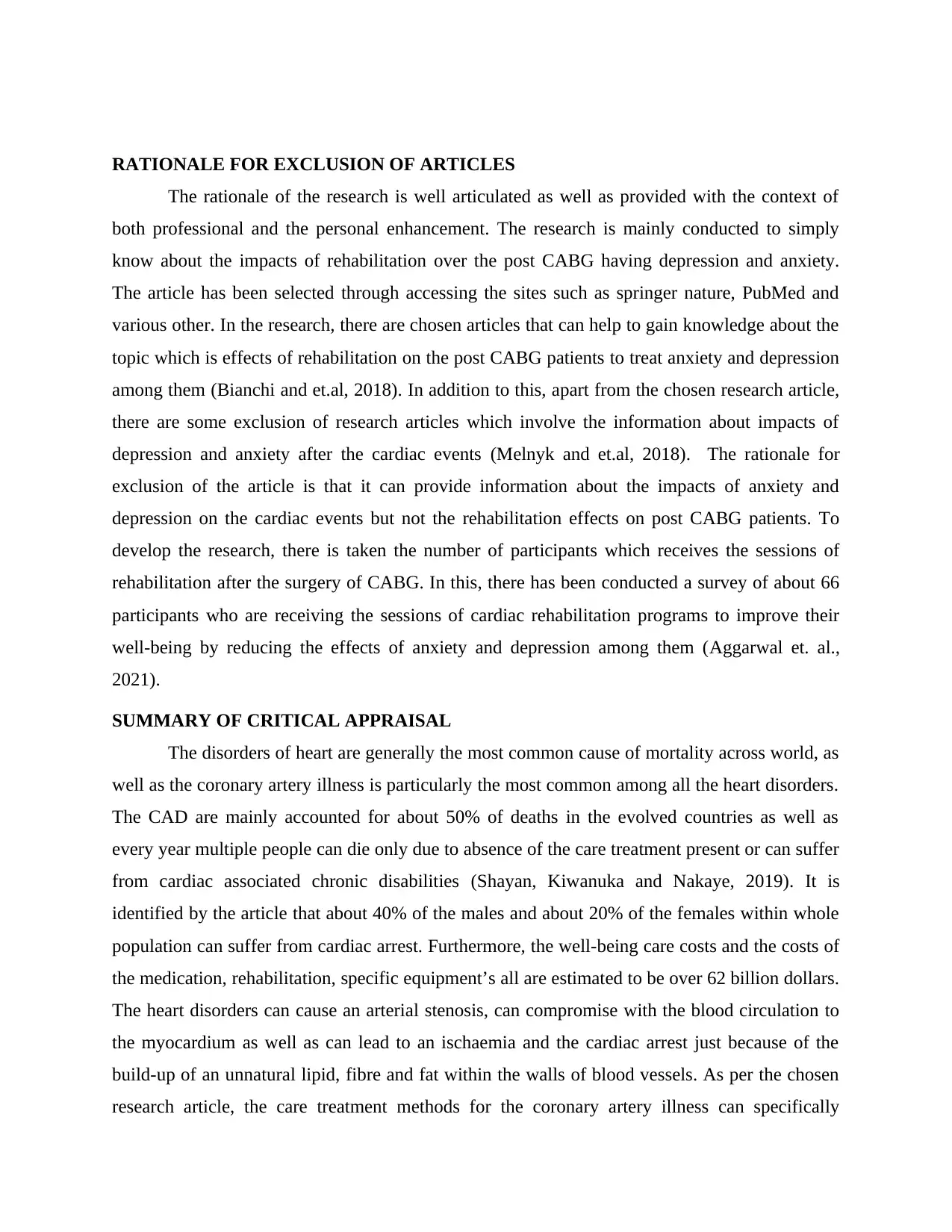
RATIONALE FOR EXCLUSION OF ARTICLES
The rationale of the research is well articulated as well as provided with the context of
both professional and the personal enhancement. The research is mainly conducted to simply
know about the impacts of rehabilitation over the post CABG having depression and anxiety.
The article has been selected through accessing the sites such as springer nature, PubMed and
various other. In the research, there are chosen articles that can help to gain knowledge about the
topic which is effects of rehabilitation on the post CABG patients to treat anxiety and depression
among them (Bianchi and et.al, 2018). In addition to this, apart from the chosen research article,
there are some exclusion of research articles which involve the information about impacts of
depression and anxiety after the cardiac events (Melnyk and et.al, 2018). The rationale for
exclusion of the article is that it can provide information about the impacts of anxiety and
depression on the cardiac events but not the rehabilitation effects on post CABG patients. To
develop the research, there is taken the number of participants which receives the sessions of
rehabilitation after the surgery of CABG. In this, there has been conducted a survey of about 66
participants who are receiving the sessions of cardiac rehabilitation programs to improve their
well-being by reducing the effects of anxiety and depression among them (Aggarwal et. al.,
2021).
SUMMARY OF CRITICAL APPRAISAL
The disorders of heart are generally the most common cause of mortality across world, as
well as the coronary artery illness is particularly the most common among all the heart disorders.
The CAD are mainly accounted for about 50% of deaths in the evolved countries as well as
every year multiple people can die only due to absence of the care treatment present or can suffer
from cardiac associated chronic disabilities (Shayan, Kiwanuka and Nakaye, 2019). It is
identified by the article that about 40% of the males and about 20% of the females within whole
population can suffer from cardiac arrest. Furthermore, the well-being care costs and the costs of
the medication, rehabilitation, specific equipment’s all are estimated to be over 62 billion dollars.
The heart disorders can cause an arterial stenosis, can compromise with the blood circulation to
the myocardium as well as can lead to an ischaemia and the cardiac arrest just because of the
build-up of an unnatural lipid, fibre and fat within the walls of blood vessels. As per the chosen
research article, the care treatment methods for the coronary artery illness can specifically
The rationale of the research is well articulated as well as provided with the context of
both professional and the personal enhancement. The research is mainly conducted to simply
know about the impacts of rehabilitation over the post CABG having depression and anxiety.
The article has been selected through accessing the sites such as springer nature, PubMed and
various other. In the research, there are chosen articles that can help to gain knowledge about the
topic which is effects of rehabilitation on the post CABG patients to treat anxiety and depression
among them (Bianchi and et.al, 2018). In addition to this, apart from the chosen research article,
there are some exclusion of research articles which involve the information about impacts of
depression and anxiety after the cardiac events (Melnyk and et.al, 2018). The rationale for
exclusion of the article is that it can provide information about the impacts of anxiety and
depression on the cardiac events but not the rehabilitation effects on post CABG patients. To
develop the research, there is taken the number of participants which receives the sessions of
rehabilitation after the surgery of CABG. In this, there has been conducted a survey of about 66
participants who are receiving the sessions of cardiac rehabilitation programs to improve their
well-being by reducing the effects of anxiety and depression among them (Aggarwal et. al.,
2021).
SUMMARY OF CRITICAL APPRAISAL
The disorders of heart are generally the most common cause of mortality across world, as
well as the coronary artery illness is particularly the most common among all the heart disorders.
The CAD are mainly accounted for about 50% of deaths in the evolved countries as well as
every year multiple people can die only due to absence of the care treatment present or can suffer
from cardiac associated chronic disabilities (Shayan, Kiwanuka and Nakaye, 2019). It is
identified by the article that about 40% of the males and about 20% of the females within whole
population can suffer from cardiac arrest. Furthermore, the well-being care costs and the costs of
the medication, rehabilitation, specific equipment’s all are estimated to be over 62 billion dollars.
The heart disorders can cause an arterial stenosis, can compromise with the blood circulation to
the myocardium as well as can lead to an ischaemia and the cardiac arrest just because of the
build-up of an unnatural lipid, fibre and fat within the walls of blood vessels. As per the chosen
research article, the care treatment methods for the coronary artery illness can specifically
Paraphrase This Document
Need a fresh take? Get an instant paraphrase of this document with our AI Paraphraser
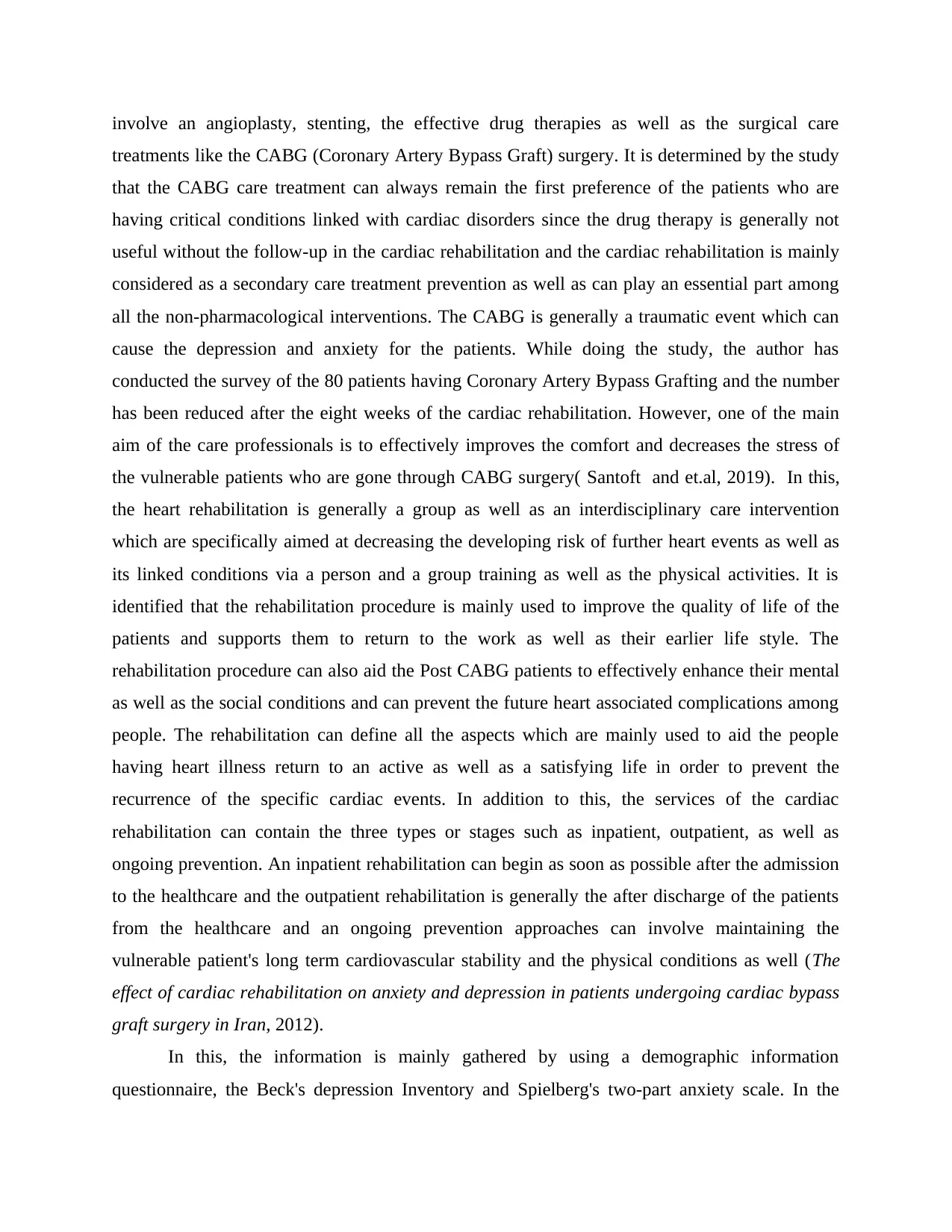
involve an angioplasty, stenting, the effective drug therapies as well as the surgical care
treatments like the CABG (Coronary Artery Bypass Graft) surgery. It is determined by the study
that the CABG care treatment can always remain the first preference of the patients who are
having critical conditions linked with cardiac disorders since the drug therapy is generally not
useful without the follow-up in the cardiac rehabilitation and the cardiac rehabilitation is mainly
considered as a secondary care treatment prevention as well as can play an essential part among
all the non-pharmacological interventions. The CABG is generally a traumatic event which can
cause the depression and anxiety for the patients. While doing the study, the author has
conducted the survey of the 80 patients having Coronary Artery Bypass Grafting and the number
has been reduced after the eight weeks of the cardiac rehabilitation. However, one of the main
aim of the care professionals is to effectively improves the comfort and decreases the stress of
the vulnerable patients who are gone through CABG surgery( Santoft and et.al, 2019). In this,
the heart rehabilitation is generally a group as well as an interdisciplinary care intervention
which are specifically aimed at decreasing the developing risk of further heart events as well as
its linked conditions via a person and a group training as well as the physical activities. It is
identified that the rehabilitation procedure is mainly used to improve the quality of life of the
patients and supports them to return to the work as well as their earlier life style. The
rehabilitation procedure can also aid the Post CABG patients to effectively enhance their mental
as well as the social conditions and can prevent the future heart associated complications among
people. The rehabilitation can define all the aspects which are mainly used to aid the people
having heart illness return to an active as well as a satisfying life in order to prevent the
recurrence of the specific cardiac events. In addition to this, the services of the cardiac
rehabilitation can contain the three types or stages such as inpatient, outpatient, as well as
ongoing prevention. An inpatient rehabilitation can begin as soon as possible after the admission
to the healthcare and the outpatient rehabilitation is generally the after discharge of the patients
from the healthcare and an ongoing prevention approaches can involve maintaining the
vulnerable patient's long term cardiovascular stability and the physical conditions as well (The
effect of cardiac rehabilitation on anxiety and depression in patients undergoing cardiac bypass
graft surgery in Iran, 2012).
In this, the information is mainly gathered by using a demographic information
questionnaire, the Beck's depression Inventory and Spielberg's two-part anxiety scale. In the
treatments like the CABG (Coronary Artery Bypass Graft) surgery. It is determined by the study
that the CABG care treatment can always remain the first preference of the patients who are
having critical conditions linked with cardiac disorders since the drug therapy is generally not
useful without the follow-up in the cardiac rehabilitation and the cardiac rehabilitation is mainly
considered as a secondary care treatment prevention as well as can play an essential part among
all the non-pharmacological interventions. The CABG is generally a traumatic event which can
cause the depression and anxiety for the patients. While doing the study, the author has
conducted the survey of the 80 patients having Coronary Artery Bypass Grafting and the number
has been reduced after the eight weeks of the cardiac rehabilitation. However, one of the main
aim of the care professionals is to effectively improves the comfort and decreases the stress of
the vulnerable patients who are gone through CABG surgery( Santoft and et.al, 2019). In this,
the heart rehabilitation is generally a group as well as an interdisciplinary care intervention
which are specifically aimed at decreasing the developing risk of further heart events as well as
its linked conditions via a person and a group training as well as the physical activities. It is
identified that the rehabilitation procedure is mainly used to improve the quality of life of the
patients and supports them to return to the work as well as their earlier life style. The
rehabilitation procedure can also aid the Post CABG patients to effectively enhance their mental
as well as the social conditions and can prevent the future heart associated complications among
people. The rehabilitation can define all the aspects which are mainly used to aid the people
having heart illness return to an active as well as a satisfying life in order to prevent the
recurrence of the specific cardiac events. In addition to this, the services of the cardiac
rehabilitation can contain the three types or stages such as inpatient, outpatient, as well as
ongoing prevention. An inpatient rehabilitation can begin as soon as possible after the admission
to the healthcare and the outpatient rehabilitation is generally the after discharge of the patients
from the healthcare and an ongoing prevention approaches can involve maintaining the
vulnerable patient's long term cardiovascular stability and the physical conditions as well (The
effect of cardiac rehabilitation on anxiety and depression in patients undergoing cardiac bypass
graft surgery in Iran, 2012).
In this, the information is mainly gathered by using a demographic information
questionnaire, the Beck's depression Inventory and Spielberg's two-part anxiety scale. In the
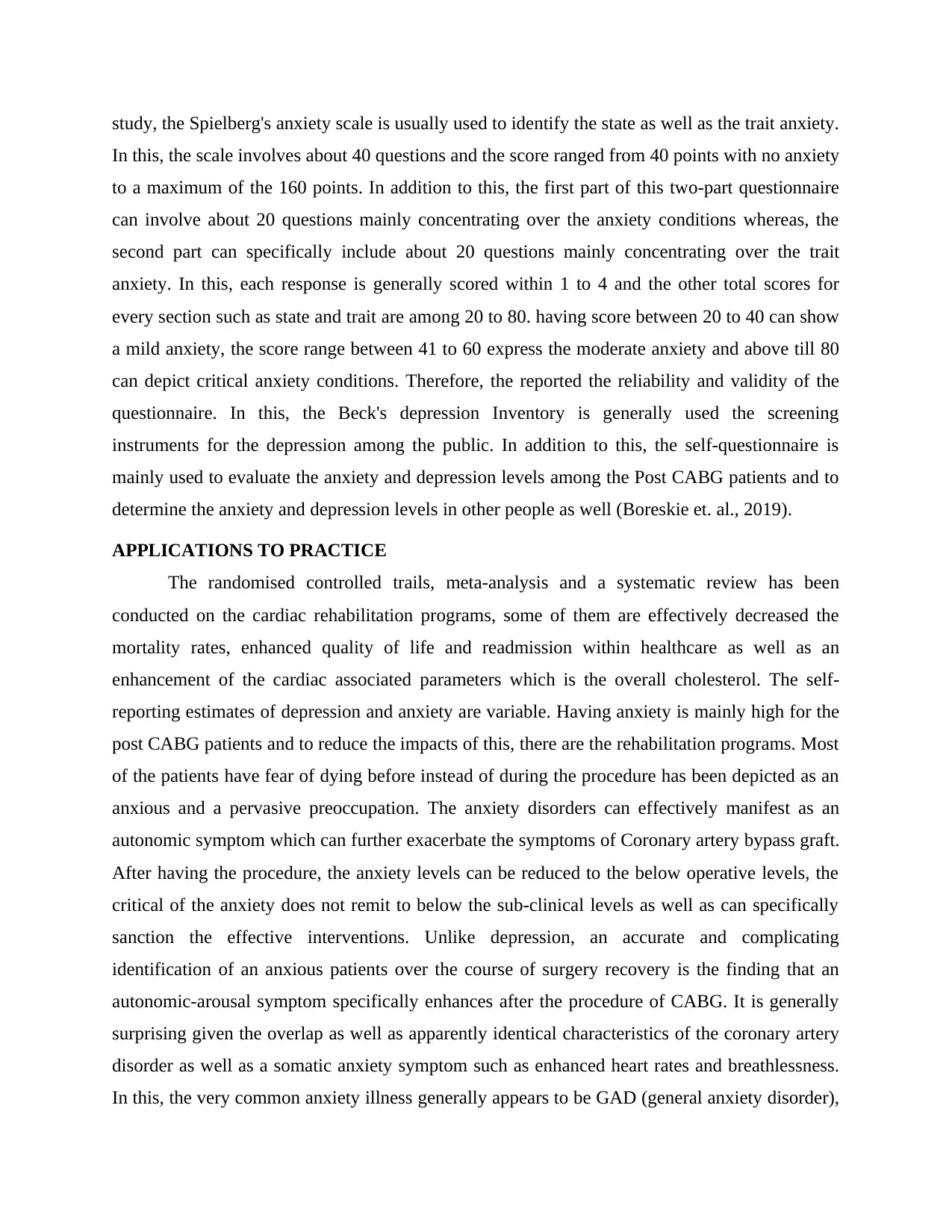
study, the Spielberg's anxiety scale is usually used to identify the state as well as the trait anxiety.
In this, the scale involves about 40 questions and the score ranged from 40 points with no anxiety
to a maximum of the 160 points. In addition to this, the first part of this two-part questionnaire
can involve about 20 questions mainly concentrating over the anxiety conditions whereas, the
second part can specifically include about 20 questions mainly concentrating over the trait
anxiety. In this, each response is generally scored within 1 to 4 and the other total scores for
every section such as state and trait are among 20 to 80. having score between 20 to 40 can show
a mild anxiety, the score range between 41 to 60 express the moderate anxiety and above till 80
can depict critical anxiety conditions. Therefore, the reported the reliability and validity of the
questionnaire. In this, the Beck's depression Inventory is generally used the screening
instruments for the depression among the public. In addition to this, the self-questionnaire is
mainly used to evaluate the anxiety and depression levels among the Post CABG patients and to
determine the anxiety and depression levels in other people as well (Boreskie et. al., 2019).
APPLICATIONS TO PRACTICE
The randomised controlled trails, meta-analysis and a systematic review has been
conducted on the cardiac rehabilitation programs, some of them are effectively decreased the
mortality rates, enhanced quality of life and readmission within healthcare as well as an
enhancement of the cardiac associated parameters which is the overall cholesterol. The self-
reporting estimates of depression and anxiety are variable. Having anxiety is mainly high for the
post CABG patients and to reduce the impacts of this, there are the rehabilitation programs. Most
of the patients have fear of dying before instead of during the procedure has been depicted as an
anxious and a pervasive preoccupation. The anxiety disorders can effectively manifest as an
autonomic symptom which can further exacerbate the symptoms of Coronary artery bypass graft.
After having the procedure, the anxiety levels can be reduced to the below operative levels, the
critical of the anxiety does not remit to below the sub-clinical levels as well as can specifically
sanction the effective interventions. Unlike depression, an accurate and complicating
identification of an anxious patients over the course of surgery recovery is the finding that an
autonomic-arousal symptom specifically enhances after the procedure of CABG. It is generally
surprising given the overlap as well as apparently identical characteristics of the coronary artery
disorder as well as a somatic anxiety symptom such as enhanced heart rates and breathlessness.
In this, the very common anxiety illness generally appears to be GAD (general anxiety disorder),
In this, the scale involves about 40 questions and the score ranged from 40 points with no anxiety
to a maximum of the 160 points. In addition to this, the first part of this two-part questionnaire
can involve about 20 questions mainly concentrating over the anxiety conditions whereas, the
second part can specifically include about 20 questions mainly concentrating over the trait
anxiety. In this, each response is generally scored within 1 to 4 and the other total scores for
every section such as state and trait are among 20 to 80. having score between 20 to 40 can show
a mild anxiety, the score range between 41 to 60 express the moderate anxiety and above till 80
can depict critical anxiety conditions. Therefore, the reported the reliability and validity of the
questionnaire. In this, the Beck's depression Inventory is generally used the screening
instruments for the depression among the public. In addition to this, the self-questionnaire is
mainly used to evaluate the anxiety and depression levels among the Post CABG patients and to
determine the anxiety and depression levels in other people as well (Boreskie et. al., 2019).
APPLICATIONS TO PRACTICE
The randomised controlled trails, meta-analysis and a systematic review has been
conducted on the cardiac rehabilitation programs, some of them are effectively decreased the
mortality rates, enhanced quality of life and readmission within healthcare as well as an
enhancement of the cardiac associated parameters which is the overall cholesterol. The self-
reporting estimates of depression and anxiety are variable. Having anxiety is mainly high for the
post CABG patients and to reduce the impacts of this, there are the rehabilitation programs. Most
of the patients have fear of dying before instead of during the procedure has been depicted as an
anxious and a pervasive preoccupation. The anxiety disorders can effectively manifest as an
autonomic symptom which can further exacerbate the symptoms of Coronary artery bypass graft.
After having the procedure, the anxiety levels can be reduced to the below operative levels, the
critical of the anxiety does not remit to below the sub-clinical levels as well as can specifically
sanction the effective interventions. Unlike depression, an accurate and complicating
identification of an anxious patients over the course of surgery recovery is the finding that an
autonomic-arousal symptom specifically enhances after the procedure of CABG. It is generally
surprising given the overlap as well as apparently identical characteristics of the coronary artery
disorder as well as a somatic anxiety symptom such as enhanced heart rates and breathlessness.
In this, the very common anxiety illness generally appears to be GAD (general anxiety disorder),
⊘ This is a preview!⊘
Do you want full access?
Subscribe today to unlock all pages.

Trusted by 1+ million students worldwide
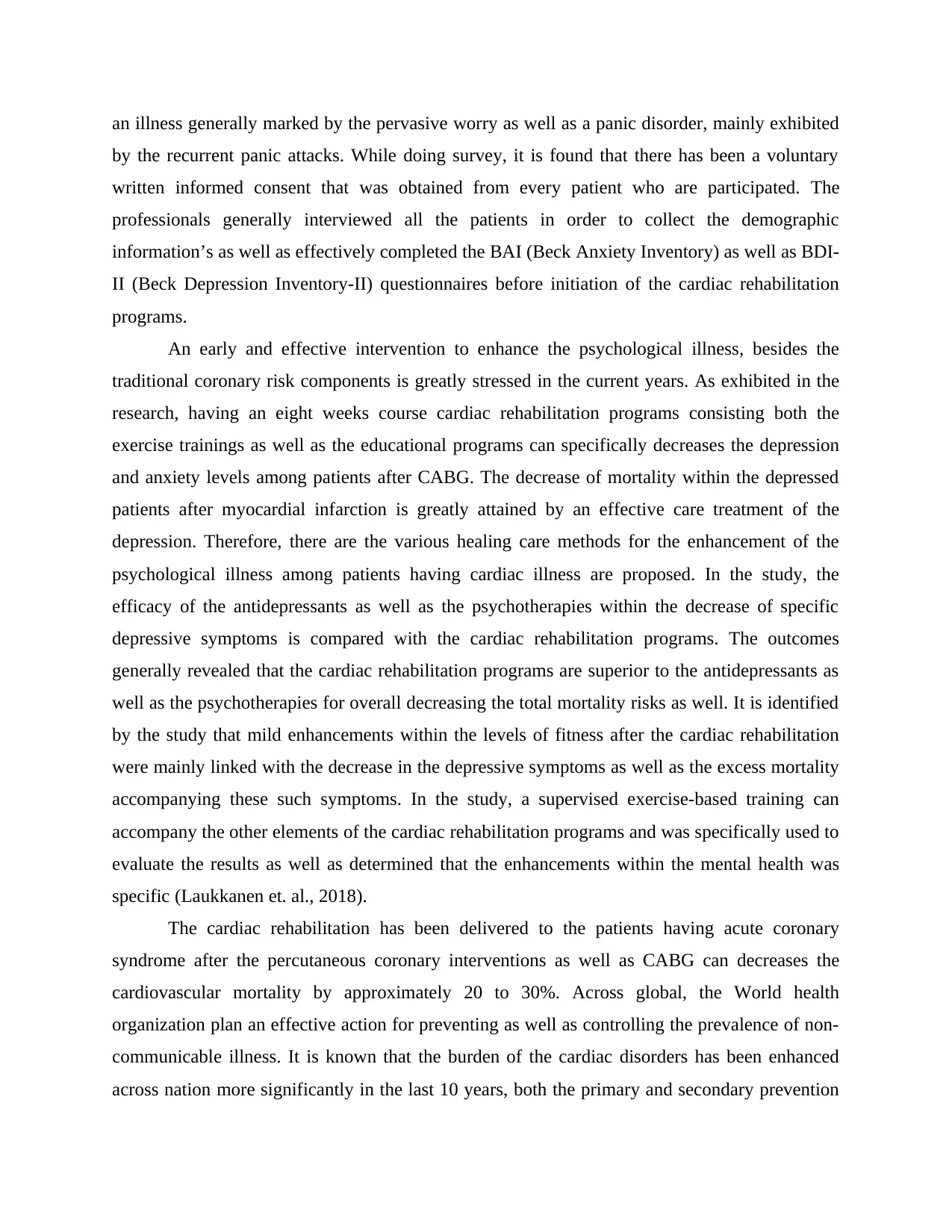
an illness generally marked by the pervasive worry as well as a panic disorder, mainly exhibited
by the recurrent panic attacks. While doing survey, it is found that there has been a voluntary
written informed consent that was obtained from every patient who are participated. The
professionals generally interviewed all the patients in order to collect the demographic
information’s as well as effectively completed the BAI (Beck Anxiety Inventory) as well as BDI-
II (Beck Depression Inventory-II) questionnaires before initiation of the cardiac rehabilitation
programs.
An early and effective intervention to enhance the psychological illness, besides the
traditional coronary risk components is greatly stressed in the current years. As exhibited in the
research, having an eight weeks course cardiac rehabilitation programs consisting both the
exercise trainings as well as the educational programs can specifically decreases the depression
and anxiety levels among patients after CABG. The decrease of mortality within the depressed
patients after myocardial infarction is greatly attained by an effective care treatment of the
depression. Therefore, there are the various healing care methods for the enhancement of the
psychological illness among patients having cardiac illness are proposed. In the study, the
efficacy of the antidepressants as well as the psychotherapies within the decrease of specific
depressive symptoms is compared with the cardiac rehabilitation programs. The outcomes
generally revealed that the cardiac rehabilitation programs are superior to the antidepressants as
well as the psychotherapies for overall decreasing the total mortality risks as well. It is identified
by the study that mild enhancements within the levels of fitness after the cardiac rehabilitation
were mainly linked with the decrease in the depressive symptoms as well as the excess mortality
accompanying these such symptoms. In the study, a supervised exercise-based training can
accompany the other elements of the cardiac rehabilitation programs and was specifically used to
evaluate the results as well as determined that the enhancements within the mental health was
specific (Laukkanen et. al., 2018).
The cardiac rehabilitation has been delivered to the patients having acute coronary
syndrome after the percutaneous coronary interventions as well as CABG can decreases the
cardiovascular mortality by approximately 20 to 30%. Across global, the World health
organization plan an effective action for preventing as well as controlling the prevalence of non-
communicable illness. It is known that the burden of the cardiac disorders has been enhanced
across nation more significantly in the last 10 years, both the primary and secondary prevention
by the recurrent panic attacks. While doing survey, it is found that there has been a voluntary
written informed consent that was obtained from every patient who are participated. The
professionals generally interviewed all the patients in order to collect the demographic
information’s as well as effectively completed the BAI (Beck Anxiety Inventory) as well as BDI-
II (Beck Depression Inventory-II) questionnaires before initiation of the cardiac rehabilitation
programs.
An early and effective intervention to enhance the psychological illness, besides the
traditional coronary risk components is greatly stressed in the current years. As exhibited in the
research, having an eight weeks course cardiac rehabilitation programs consisting both the
exercise trainings as well as the educational programs can specifically decreases the depression
and anxiety levels among patients after CABG. The decrease of mortality within the depressed
patients after myocardial infarction is greatly attained by an effective care treatment of the
depression. Therefore, there are the various healing care methods for the enhancement of the
psychological illness among patients having cardiac illness are proposed. In the study, the
efficacy of the antidepressants as well as the psychotherapies within the decrease of specific
depressive symptoms is compared with the cardiac rehabilitation programs. The outcomes
generally revealed that the cardiac rehabilitation programs are superior to the antidepressants as
well as the psychotherapies for overall decreasing the total mortality risks as well. It is identified
by the study that mild enhancements within the levels of fitness after the cardiac rehabilitation
were mainly linked with the decrease in the depressive symptoms as well as the excess mortality
accompanying these such symptoms. In the study, a supervised exercise-based training can
accompany the other elements of the cardiac rehabilitation programs and was specifically used to
evaluate the results as well as determined that the enhancements within the mental health was
specific (Laukkanen et. al., 2018).
The cardiac rehabilitation has been delivered to the patients having acute coronary
syndrome after the percutaneous coronary interventions as well as CABG can decreases the
cardiovascular mortality by approximately 20 to 30%. Across global, the World health
organization plan an effective action for preventing as well as controlling the prevalence of non-
communicable illness. It is known that the burden of the cardiac disorders has been enhanced
across nation more significantly in the last 10 years, both the primary and secondary prevention
Paraphrase This Document
Need a fresh take? Get an instant paraphrase of this document with our AI Paraphraser
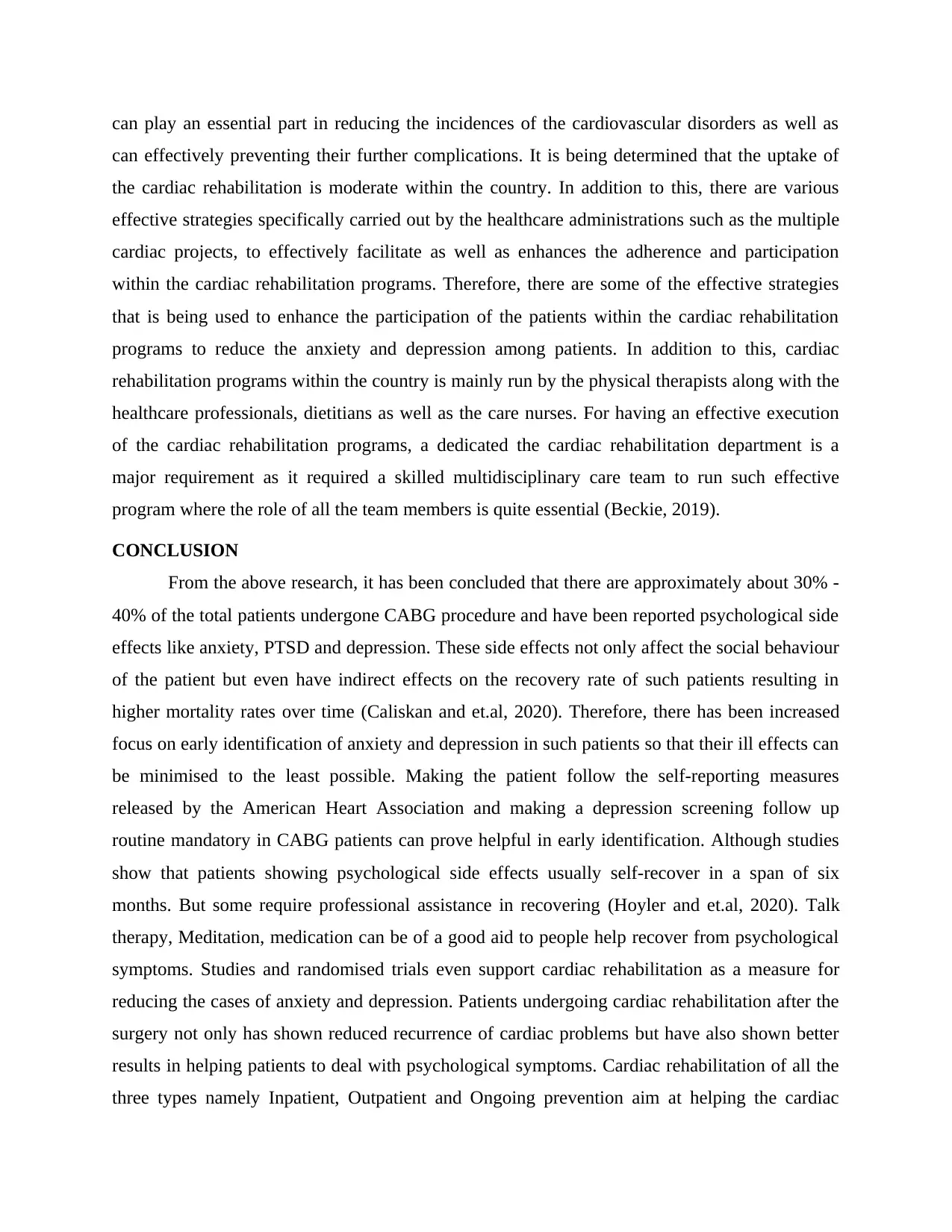
can play an essential part in reducing the incidences of the cardiovascular disorders as well as
can effectively preventing their further complications. It is being determined that the uptake of
the cardiac rehabilitation is moderate within the country. In addition to this, there are various
effective strategies specifically carried out by the healthcare administrations such as the multiple
cardiac projects, to effectively facilitate as well as enhances the adherence and participation
within the cardiac rehabilitation programs. Therefore, there are some of the effective strategies
that is being used to enhance the participation of the patients within the cardiac rehabilitation
programs to reduce the anxiety and depression among patients. In addition to this, cardiac
rehabilitation programs within the country is mainly run by the physical therapists along with the
healthcare professionals, dietitians as well as the care nurses. For having an effective execution
of the cardiac rehabilitation programs, a dedicated the cardiac rehabilitation department is a
major requirement as it required a skilled multidisciplinary care team to run such effective
program where the role of all the team members is quite essential (Beckie, 2019).
CONCLUSION
From the above research, it has been concluded that there are approximately about 30% -
40% of the total patients undergone CABG procedure and have been reported psychological side
effects like anxiety, PTSD and depression. These side effects not only affect the social behaviour
of the patient but even have indirect effects on the recovery rate of such patients resulting in
higher mortality rates over time (Caliskan and et.al, 2020). Therefore, there has been increased
focus on early identification of anxiety and depression in such patients so that their ill effects can
be minimised to the least possible. Making the patient follow the self-reporting measures
released by the American Heart Association and making a depression screening follow up
routine mandatory in CABG patients can prove helpful in early identification. Although studies
show that patients showing psychological side effects usually self-recover in a span of six
months. But some require professional assistance in recovering (Hoyler and et.al, 2020). Talk
therapy, Meditation, medication can be of a good aid to people help recover from psychological
symptoms. Studies and randomised trials even support cardiac rehabilitation as a measure for
reducing the cases of anxiety and depression. Patients undergoing cardiac rehabilitation after the
surgery not only has shown reduced recurrence of cardiac problems but have also shown better
results in helping patients to deal with psychological symptoms. Cardiac rehabilitation of all the
three types namely Inpatient, Outpatient and Ongoing prevention aim at helping the cardiac
can effectively preventing their further complications. It is being determined that the uptake of
the cardiac rehabilitation is moderate within the country. In addition to this, there are various
effective strategies specifically carried out by the healthcare administrations such as the multiple
cardiac projects, to effectively facilitate as well as enhances the adherence and participation
within the cardiac rehabilitation programs. Therefore, there are some of the effective strategies
that is being used to enhance the participation of the patients within the cardiac rehabilitation
programs to reduce the anxiety and depression among patients. In addition to this, cardiac
rehabilitation programs within the country is mainly run by the physical therapists along with the
healthcare professionals, dietitians as well as the care nurses. For having an effective execution
of the cardiac rehabilitation programs, a dedicated the cardiac rehabilitation department is a
major requirement as it required a skilled multidisciplinary care team to run such effective
program where the role of all the team members is quite essential (Beckie, 2019).
CONCLUSION
From the above research, it has been concluded that there are approximately about 30% -
40% of the total patients undergone CABG procedure and have been reported psychological side
effects like anxiety, PTSD and depression. These side effects not only affect the social behaviour
of the patient but even have indirect effects on the recovery rate of such patients resulting in
higher mortality rates over time (Caliskan and et.al, 2020). Therefore, there has been increased
focus on early identification of anxiety and depression in such patients so that their ill effects can
be minimised to the least possible. Making the patient follow the self-reporting measures
released by the American Heart Association and making a depression screening follow up
routine mandatory in CABG patients can prove helpful in early identification. Although studies
show that patients showing psychological side effects usually self-recover in a span of six
months. But some require professional assistance in recovering (Hoyler and et.al, 2020). Talk
therapy, Meditation, medication can be of a good aid to people help recover from psychological
symptoms. Studies and randomised trials even support cardiac rehabilitation as a measure for
reducing the cases of anxiety and depression. Patients undergoing cardiac rehabilitation after the
surgery not only has shown reduced recurrence of cardiac problems but have also shown better
results in helping patients to deal with psychological symptoms. Cardiac rehabilitation of all the
three types namely Inpatient, Outpatient and Ongoing prevention aim at helping the cardiac
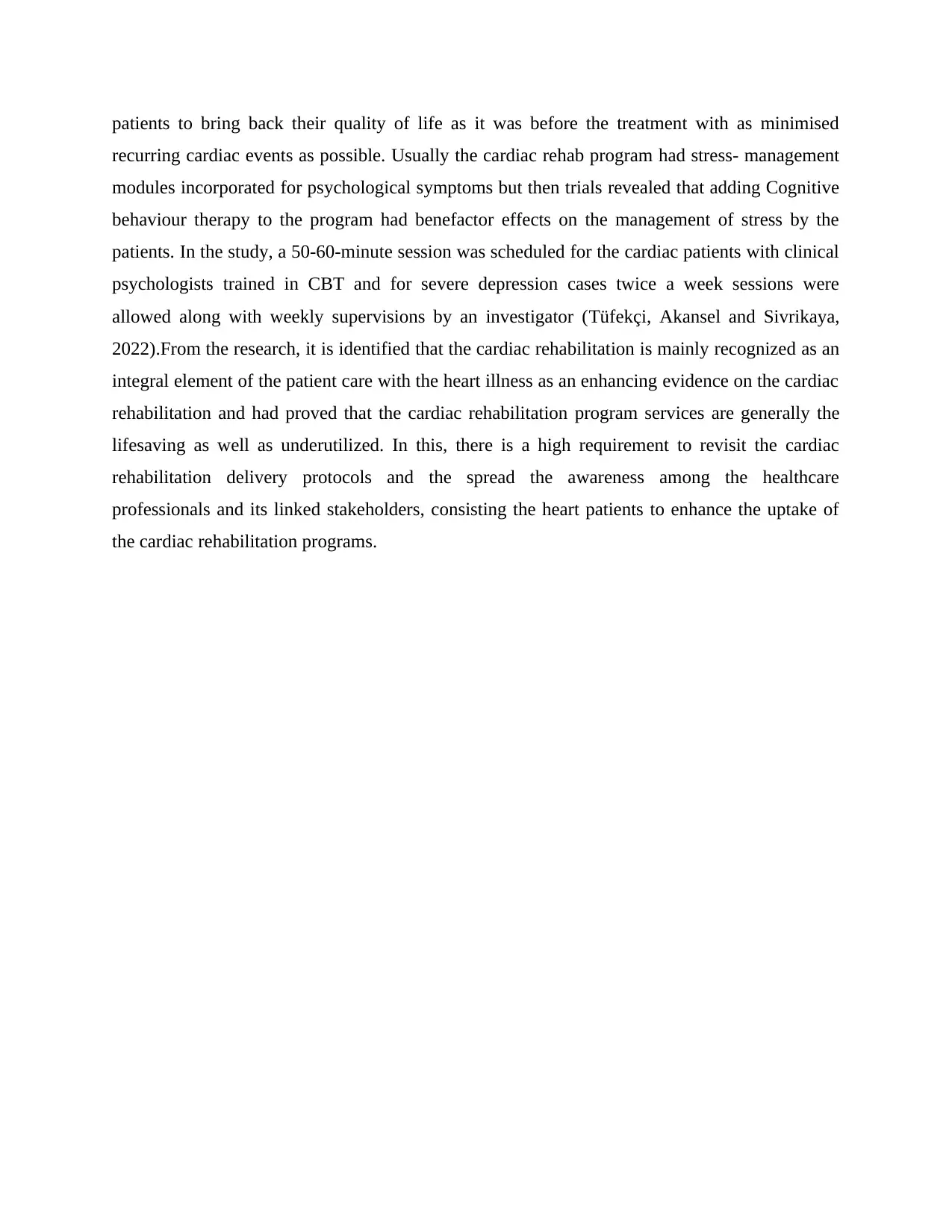
patients to bring back their quality of life as it was before the treatment with as minimised
recurring cardiac events as possible. Usually the cardiac rehab program had stress- management
modules incorporated for psychological symptoms but then trials revealed that adding Cognitive
behaviour therapy to the program had benefactor effects on the management of stress by the
patients. In the study, a 50-60-minute session was scheduled for the cardiac patients with clinical
psychologists trained in CBT and for severe depression cases twice a week sessions were
allowed along with weekly supervisions by an investigator (Tüfekçi, Akansel and Sivrikaya,
2022).From the research, it is identified that the cardiac rehabilitation is mainly recognized as an
integral element of the patient care with the heart illness as an enhancing evidence on the cardiac
rehabilitation and had proved that the cardiac rehabilitation program services are generally the
lifesaving as well as underutilized. In this, there is a high requirement to revisit the cardiac
rehabilitation delivery protocols and the spread the awareness among the healthcare
professionals and its linked stakeholders, consisting the heart patients to enhance the uptake of
the cardiac rehabilitation programs.
recurring cardiac events as possible. Usually the cardiac rehab program had stress- management
modules incorporated for psychological symptoms but then trials revealed that adding Cognitive
behaviour therapy to the program had benefactor effects on the management of stress by the
patients. In the study, a 50-60-minute session was scheduled for the cardiac patients with clinical
psychologists trained in CBT and for severe depression cases twice a week sessions were
allowed along with weekly supervisions by an investigator (Tüfekçi, Akansel and Sivrikaya,
2022).From the research, it is identified that the cardiac rehabilitation is mainly recognized as an
integral element of the patient care with the heart illness as an enhancing evidence on the cardiac
rehabilitation and had proved that the cardiac rehabilitation program services are generally the
lifesaving as well as underutilized. In this, there is a high requirement to revisit the cardiac
rehabilitation delivery protocols and the spread the awareness among the healthcare
professionals and its linked stakeholders, consisting the heart patients to enhance the uptake of
the cardiac rehabilitation programs.
⊘ This is a preview!⊘
Do you want full access?
Subscribe today to unlock all pages.

Trusted by 1+ million students worldwide
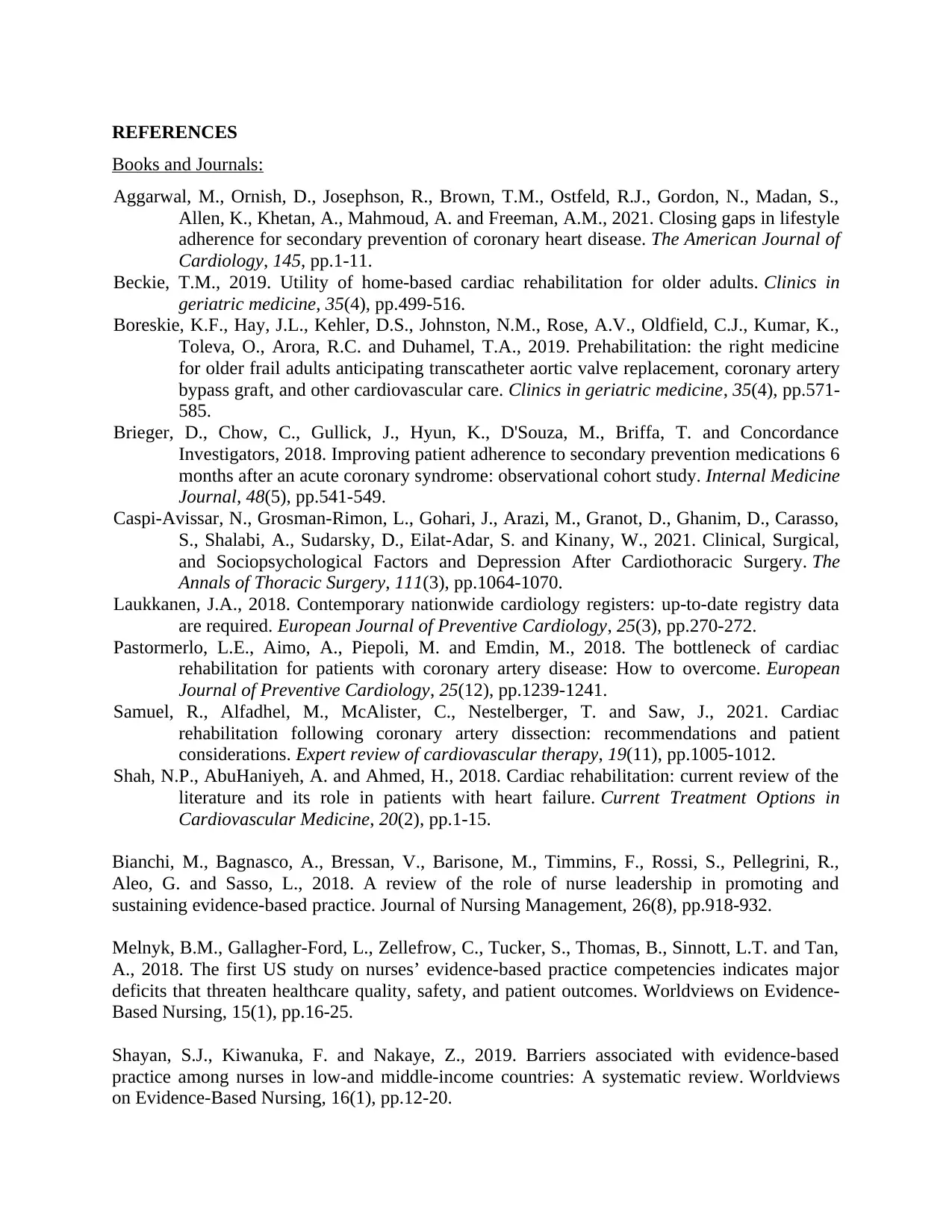
REFERENCES
Books and Journals:
Aggarwal, M., Ornish, D., Josephson, R., Brown, T.M., Ostfeld, R.J., Gordon, N., Madan, S.,
Allen, K., Khetan, A., Mahmoud, A. and Freeman, A.M., 2021. Closing gaps in lifestyle
adherence for secondary prevention of coronary heart disease. The American Journal of
Cardiology, 145, pp.1-11.
Beckie, T.M., 2019. Utility of home-based cardiac rehabilitation for older adults. Clinics in
geriatric medicine, 35(4), pp.499-516.
Boreskie, K.F., Hay, J.L., Kehler, D.S., Johnston, N.M., Rose, A.V., Oldfield, C.J., Kumar, K.,
Toleva, O., Arora, R.C. and Duhamel, T.A., 2019. Prehabilitation: the right medicine
for older frail adults anticipating transcatheter aortic valve replacement, coronary artery
bypass graft, and other cardiovascular care. Clinics in geriatric medicine, 35(4), pp.571-
585.
Brieger, D., Chow, C., Gullick, J., Hyun, K., D'Souza, M., Briffa, T. and Concordance
Investigators, 2018. Improving patient adherence to secondary prevention medications 6
months after an acute coronary syndrome: observational cohort study. Internal Medicine
Journal, 48(5), pp.541-549.
Caspi-Avissar, N., Grosman-Rimon, L., Gohari, J., Arazi, M., Granot, D., Ghanim, D., Carasso,
S., Shalabi, A., Sudarsky, D., Eilat-Adar, S. and Kinany, W., 2021. Clinical, Surgical,
and Sociopsychological Factors and Depression After Cardiothoracic Surgery. The
Annals of Thoracic Surgery, 111(3), pp.1064-1070.
Laukkanen, J.A., 2018. Contemporary nationwide cardiology registers: up-to-date registry data
are required. European Journal of Preventive Cardiology, 25(3), pp.270-272.
Pastormerlo, L.E., Aimo, A., Piepoli, M. and Emdin, M., 2018. The bottleneck of cardiac
rehabilitation for patients with coronary artery disease: How to overcome. European
Journal of Preventive Cardiology, 25(12), pp.1239-1241.
Samuel, R., Alfadhel, M., McAlister, C., Nestelberger, T. and Saw, J., 2021. Cardiac
rehabilitation following coronary artery dissection: recommendations and patient
considerations. Expert review of cardiovascular therapy, 19(11), pp.1005-1012.
Shah, N.P., AbuHaniyeh, A. and Ahmed, H., 2018. Cardiac rehabilitation: current review of the
literature and its role in patients with heart failure. Current Treatment Options in
Cardiovascular Medicine, 20(2), pp.1-15.
Bianchi, M., Bagnasco, A., Bressan, V., Barisone, M., Timmins, F., Rossi, S., Pellegrini, R.,
Aleo, G. and Sasso, L., 2018. A review of the role of nurse leadership in promoting and
sustaining evidence‐based practice. Journal of Nursing Management, 26(8), pp.918-932.
Melnyk, B.M., Gallagher‐Ford, L., Zellefrow, C., Tucker, S., Thomas, B., Sinnott, L.T. and Tan,
A., 2018. The first US study on nurses’ evidence‐based practice competencies indicates major
deficits that threaten healthcare quality, safety, and patient outcomes. Worldviews on Evidence‐
Based Nursing, 15(1), pp.16-25.
Shayan, S.J., Kiwanuka, F. and Nakaye, Z., 2019. Barriers associated with evidence‐based
practice among nurses in low‐and middle‐income countries: A systematic review. Worldviews
on Evidence‐Based Nursing, 16(1), pp.12-20.
Books and Journals:
Aggarwal, M., Ornish, D., Josephson, R., Brown, T.M., Ostfeld, R.J., Gordon, N., Madan, S.,
Allen, K., Khetan, A., Mahmoud, A. and Freeman, A.M., 2021. Closing gaps in lifestyle
adherence for secondary prevention of coronary heart disease. The American Journal of
Cardiology, 145, pp.1-11.
Beckie, T.M., 2019. Utility of home-based cardiac rehabilitation for older adults. Clinics in
geriatric medicine, 35(4), pp.499-516.
Boreskie, K.F., Hay, J.L., Kehler, D.S., Johnston, N.M., Rose, A.V., Oldfield, C.J., Kumar, K.,
Toleva, O., Arora, R.C. and Duhamel, T.A., 2019. Prehabilitation: the right medicine
for older frail adults anticipating transcatheter aortic valve replacement, coronary artery
bypass graft, and other cardiovascular care. Clinics in geriatric medicine, 35(4), pp.571-
585.
Brieger, D., Chow, C., Gullick, J., Hyun, K., D'Souza, M., Briffa, T. and Concordance
Investigators, 2018. Improving patient adherence to secondary prevention medications 6
months after an acute coronary syndrome: observational cohort study. Internal Medicine
Journal, 48(5), pp.541-549.
Caspi-Avissar, N., Grosman-Rimon, L., Gohari, J., Arazi, M., Granot, D., Ghanim, D., Carasso,
S., Shalabi, A., Sudarsky, D., Eilat-Adar, S. and Kinany, W., 2021. Clinical, Surgical,
and Sociopsychological Factors and Depression After Cardiothoracic Surgery. The
Annals of Thoracic Surgery, 111(3), pp.1064-1070.
Laukkanen, J.A., 2018. Contemporary nationwide cardiology registers: up-to-date registry data
are required. European Journal of Preventive Cardiology, 25(3), pp.270-272.
Pastormerlo, L.E., Aimo, A., Piepoli, M. and Emdin, M., 2018. The bottleneck of cardiac
rehabilitation for patients with coronary artery disease: How to overcome. European
Journal of Preventive Cardiology, 25(12), pp.1239-1241.
Samuel, R., Alfadhel, M., McAlister, C., Nestelberger, T. and Saw, J., 2021. Cardiac
rehabilitation following coronary artery dissection: recommendations and patient
considerations. Expert review of cardiovascular therapy, 19(11), pp.1005-1012.
Shah, N.P., AbuHaniyeh, A. and Ahmed, H., 2018. Cardiac rehabilitation: current review of the
literature and its role in patients with heart failure. Current Treatment Options in
Cardiovascular Medicine, 20(2), pp.1-15.
Bianchi, M., Bagnasco, A., Bressan, V., Barisone, M., Timmins, F., Rossi, S., Pellegrini, R.,
Aleo, G. and Sasso, L., 2018. A review of the role of nurse leadership in promoting and
sustaining evidence‐based practice. Journal of Nursing Management, 26(8), pp.918-932.
Melnyk, B.M., Gallagher‐Ford, L., Zellefrow, C., Tucker, S., Thomas, B., Sinnott, L.T. and Tan,
A., 2018. The first US study on nurses’ evidence‐based practice competencies indicates major
deficits that threaten healthcare quality, safety, and patient outcomes. Worldviews on Evidence‐
Based Nursing, 15(1), pp.16-25.
Shayan, S.J., Kiwanuka, F. and Nakaye, Z., 2019. Barriers associated with evidence‐based
practice among nurses in low‐and middle‐income countries: A systematic review. Worldviews
on Evidence‐Based Nursing, 16(1), pp.12-20.
Paraphrase This Document
Need a fresh take? Get an instant paraphrase of this document with our AI Paraphraser
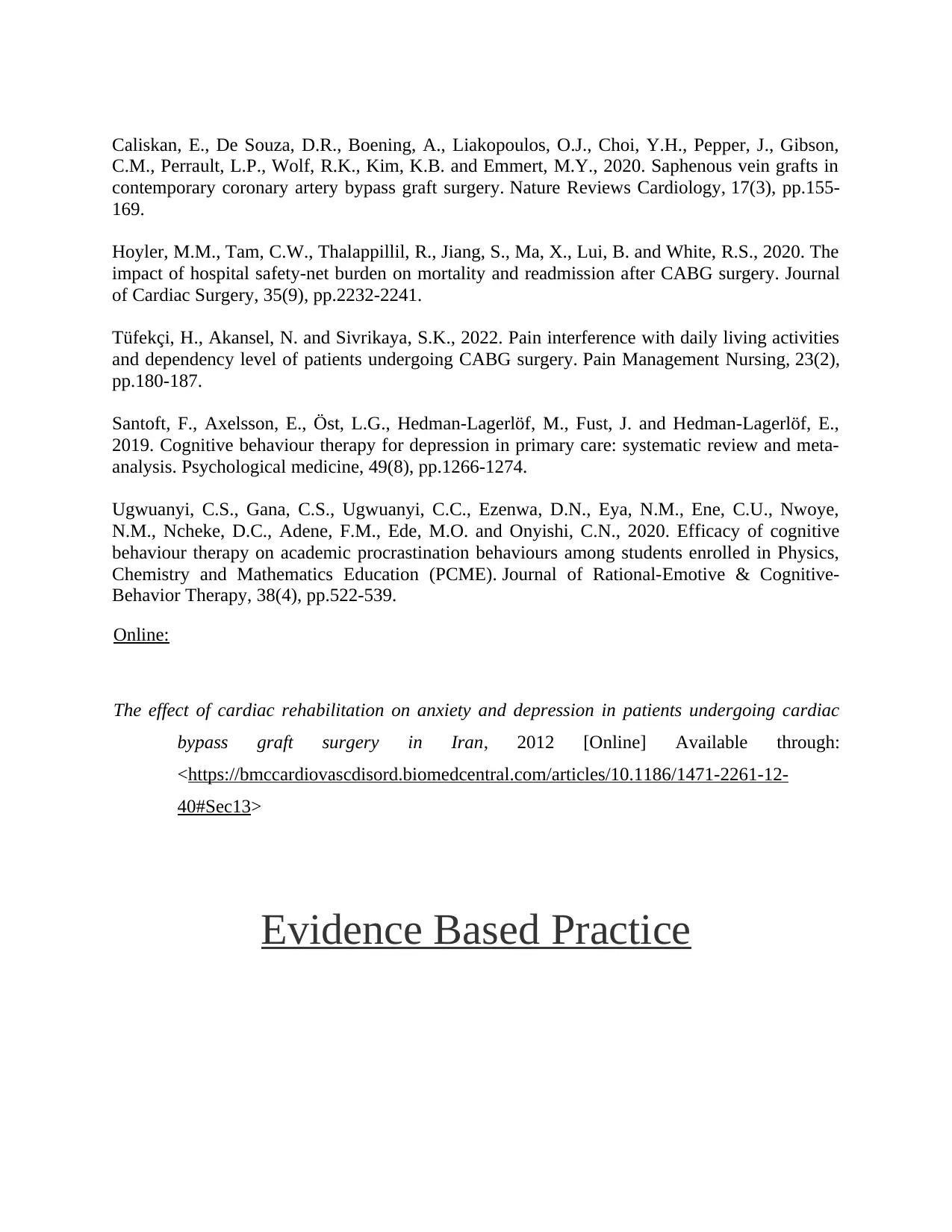
Caliskan, E., De Souza, D.R., Boening, A., Liakopoulos, O.J., Choi, Y.H., Pepper, J., Gibson,
C.M., Perrault, L.P., Wolf, R.K., Kim, K.B. and Emmert, M.Y., 2020. Saphenous vein grafts in
contemporary coronary artery bypass graft surgery. Nature Reviews Cardiology, 17(3), pp.155-
169.
Hoyler, M.M., Tam, C.W., Thalappillil, R., Jiang, S., Ma, X., Lui, B. and White, R.S., 2020. The
impact of hospital safety‐net burden on mortality and readmission after CABG surgery. Journal
of Cardiac Surgery, 35(9), pp.2232-2241.
Tüfekçi, H., Akansel, N. and Sivrikaya, S.K., 2022. Pain interference with daily living activities
and dependency level of patients undergoing CABG surgery. Pain Management Nursing, 23(2),
pp.180-187.
Santoft, F., Axelsson, E., Öst, L.G., Hedman-Lagerlöf, M., Fust, J. and Hedman-Lagerlöf, E.,
2019. Cognitive behaviour therapy for depression in primary care: systematic review and meta-
analysis. Psychological medicine, 49(8), pp.1266-1274.
Ugwuanyi, C.S., Gana, C.S., Ugwuanyi, C.C., Ezenwa, D.N., Eya, N.M., Ene, C.U., Nwoye,
N.M., Ncheke, D.C., Adene, F.M., Ede, M.O. and Onyishi, C.N., 2020. Efficacy of cognitive
behaviour therapy on academic procrastination behaviours among students enrolled in Physics,
Chemistry and Mathematics Education (PCME). Journal of Rational-Emotive & Cognitive-
Behavior Therapy, 38(4), pp.522-539.
Online:
The effect of cardiac rehabilitation on anxiety and depression in patients undergoing cardiac
bypass graft surgery in Iran, 2012 [Online] Available through:
<https://bmccardiovascdisord.biomedcentral.com/articles/10.1186/1471-2261-12-
40#Sec13>
Evidence Based Practice
C.M., Perrault, L.P., Wolf, R.K., Kim, K.B. and Emmert, M.Y., 2020. Saphenous vein grafts in
contemporary coronary artery bypass graft surgery. Nature Reviews Cardiology, 17(3), pp.155-
169.
Hoyler, M.M., Tam, C.W., Thalappillil, R., Jiang, S., Ma, X., Lui, B. and White, R.S., 2020. The
impact of hospital safety‐net burden on mortality and readmission after CABG surgery. Journal
of Cardiac Surgery, 35(9), pp.2232-2241.
Tüfekçi, H., Akansel, N. and Sivrikaya, S.K., 2022. Pain interference with daily living activities
and dependency level of patients undergoing CABG surgery. Pain Management Nursing, 23(2),
pp.180-187.
Santoft, F., Axelsson, E., Öst, L.G., Hedman-Lagerlöf, M., Fust, J. and Hedman-Lagerlöf, E.,
2019. Cognitive behaviour therapy for depression in primary care: systematic review and meta-
analysis. Psychological medicine, 49(8), pp.1266-1274.
Ugwuanyi, C.S., Gana, C.S., Ugwuanyi, C.C., Ezenwa, D.N., Eya, N.M., Ene, C.U., Nwoye,
N.M., Ncheke, D.C., Adene, F.M., Ede, M.O. and Onyishi, C.N., 2020. Efficacy of cognitive
behaviour therapy on academic procrastination behaviours among students enrolled in Physics,
Chemistry and Mathematics Education (PCME). Journal of Rational-Emotive & Cognitive-
Behavior Therapy, 38(4), pp.522-539.
Online:
The effect of cardiac rehabilitation on anxiety and depression in patients undergoing cardiac
bypass graft surgery in Iran, 2012 [Online] Available through:
<https://bmccardiovascdisord.biomedcentral.com/articles/10.1186/1471-2261-12-
40#Sec13>
Evidence Based Practice
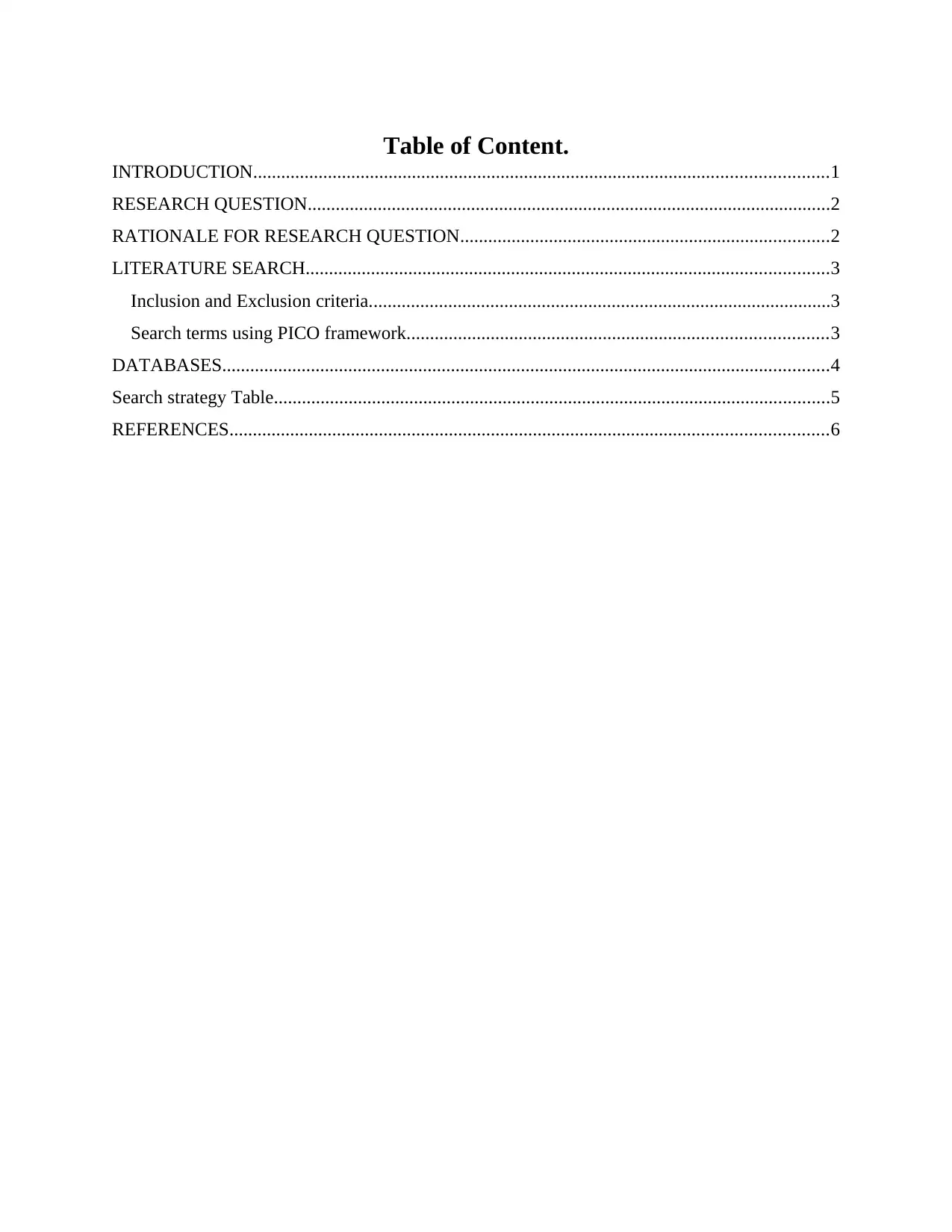
Table of Content.
INTRODUCTION...........................................................................................................................1
RESEARCH QUESTION................................................................................................................2
RATIONALE FOR RESEARCH QUESTION...............................................................................2
LITERATURE SEARCH................................................................................................................3
Inclusion and Exclusion criteria...................................................................................................3
Search terms using PICO framework..........................................................................................3
DATABASES..................................................................................................................................4
Search strategy Table.......................................................................................................................5
REFERENCES................................................................................................................................6
INTRODUCTION...........................................................................................................................1
RESEARCH QUESTION................................................................................................................2
RATIONALE FOR RESEARCH QUESTION...............................................................................2
LITERATURE SEARCH................................................................................................................3
Inclusion and Exclusion criteria...................................................................................................3
Search terms using PICO framework..........................................................................................3
DATABASES..................................................................................................................................4
Search strategy Table.......................................................................................................................5
REFERENCES................................................................................................................................6
⊘ This is a preview!⊘
Do you want full access?
Subscribe today to unlock all pages.

Trusted by 1+ million students worldwide
1 out of 21
Related Documents
Your All-in-One AI-Powered Toolkit for Academic Success.
+13062052269
info@desklib.com
Available 24*7 on WhatsApp / Email
![[object Object]](/_next/static/media/star-bottom.7253800d.svg)
Unlock your academic potential
Copyright © 2020–2025 A2Z Services. All Rights Reserved. Developed and managed by ZUCOL.




